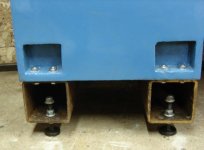O
old#7
Guest
Hi all, Great forum.
I am new to machine work and have a question about setting a lathe up.
I bought a Precision Matthews 14x40 lathe recently with gunsmithing as the intended use. I also am building a new shop structure to house tooling.
My question is ... What would be the best way to mount the lathe to the floor. I am a tall guy and would like to raise it up about 4 to 6 inches to save my back. I haven't poured the concrete floor yet and was thinking of making an embed plate with welded rebar attached to it and place it in a thickened portion of the slab around 12" deeep. The embeded plate would also have (4) pieces of 1.5" threaded rod that would support a .75" base plate with adjusting nuts for leveling. This plate would be at each end of the lathe.
Will this work or is there a better method for ridgidly attaching the machine to the floor?
I am new to machine work and have a question about setting a lathe up.
I bought a Precision Matthews 14x40 lathe recently with gunsmithing as the intended use. I also am building a new shop structure to house tooling.
My question is ... What would be the best way to mount the lathe to the floor. I am a tall guy and would like to raise it up about 4 to 6 inches to save my back. I haven't poured the concrete floor yet and was thinking of making an embed plate with welded rebar attached to it and place it in a thickened portion of the slab around 12" deeep. The embeded plate would also have (4) pieces of 1.5" threaded rod that would support a .75" base plate with adjusting nuts for leveling. This plate would be at each end of the lathe.
Will this work or is there a better method for ridgidly attaching the machine to the floor?
Last edited by a moderator:



